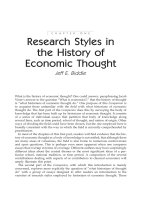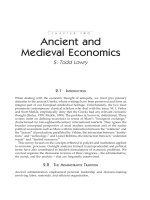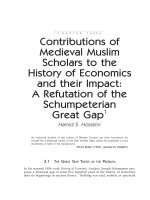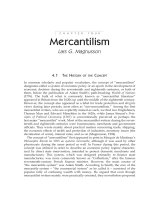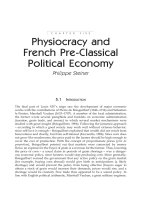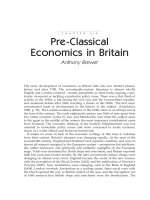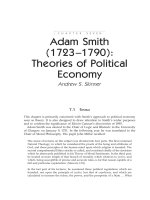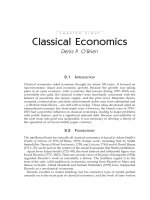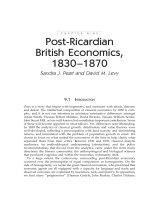A Companion to the History of Economic Thought - Chapter 10 docx
Bạn đang xem bản rút gọn của tài liệu. Xem và tải ngay bản đầy đủ của tài liệu tại đây (256.4 KB, 19 trang )
148 G. REUTEN
CHAPTER TEN
Karl Marx: His Work
and the Major
Changes in its
Interpretation
Geert Reuten
10.1 INTRODUCTION
Karl Marx is known for a 30-page political pamphlet, The Communist Manifesto,
written in 1848 together with Friedrich Engels, and for a 2,200-page socio-
economic work, Capital, published in three volumes in 1867, 1885, and 1894, the
last two edited by Engels. The collected works of Marx and Engels extend to over
50 thick volumes.
Marx’s magnum opus, Capital, is an analysis of the capitalist system (the term
“communism” is mentioned some five times in notes; perhaps five out of 2,200
pages refer in passing to some future society). Marx wrote the work between
1857 and 1878 while living in London. British capitalism provided his main em-
pirical material.
The changing appreciation of Capital throughout the twentieth century was
influenced by both the degree to which other works of Marx were, or could be,
taken into account (section 10.3) and, relatedly, developing methodological views
(section 10.4). A reading of the work (section 10.5) is bound to take methodolo-
gical sides.
KARL MARX: HIS WORK AND ITS INTERPRETATION 149
10.2 ON MARX AND HIS CAPITAL
Marx was born in 1818 in Trier and died in 1883 in London. He studied law and
philosophy and received a Ph.D. in 1841. Trained to pursue the positions of
either a state official or university professor, both his studies and the repressive
political climate in Prussia induced a different course. During his student years
he helped fight for democratic rights, opposing the vested political regime. His
subsequent writings and editorship of a liberal journal brought him into conflict
with Prussian censorship. He sought refuge in Paris (1843–5), Brussels (1845–7),
and Cologne (1848–9) and finally, in 1849, settled in London.
In the hectic 1842–9 period, Marx studied and wrote on philosophical, political,
and economic issues, and developed his materialist conception of history (sec-
tion 10.4.1). He also made contact with radical socialist groups, and met Friedrich
Engels, his lifelong personal, political, and intellectual friend. In 1848, aged 30, he
and Engels wrote the Manifest der Kommunistischen Partei.
From 1849 to about 1865, Marx reduced his political activities and concentrated
on serious analysis of the capitalist system, combining research with journalistic
work to earn his living. Many thousands of pages were drafted for his magnum
opus in a creative and highly productive period. At the same time, he and his
family lived in poverty. Income from Marx’s journalistic work was scarce; to
survive they relied on gifts from relatives and friends, especially Engels.
Marx’s research plans were extremely ambitious. He aimed to write a complete
systematic analysis of society: economic, social, political, and historical. By 1858
he planned to write six books. The first of these came to completely occupy his
mind and energies. It grew to the three volumes of Capital that we now have,
together with a sequel account of political economic theories (another three
volumes). Marx brought to press himself only the first volume of Capital
(1867).
After its 1867 publication, Marx continually revised volume I, especially its key
value-theoretical Part 1 (the volumes are organized into parts). A second German
edition dates from 1873 and a French, in installments, from 1872–5. This process
of revision should be kept in mind for those who seek consistency between
volume I and the manuscripts for volume III, composed in 1864–5.
In the years 1865–70 and 1877–8, Marx wrote much of volume II of Capital,
without completing it. He had gotten re-involved in political activities, but his
health also seriously deteriorated. As we will see below, Marx’s Capital project
employs a demanding systematic methodology. Toward the end of his life, the
requirements for the organization of the work grew beyond his fading energy.
After Marx’s death, the two remaining volumes of Capital were edited from
Marx’s drafts and notebooks by Engels (1885, 1894) and the sequel by Kautsky
(1905–10). The drafts are in varied states of completion – the second half of
both volumes II and III consists of reorganized notebooks – and the editors
inevitably had their impact on the result. In fact, Marx had considered them unfit
for publication.
150 G. REUTEN
Table 10.1 “Many Marxes”: dates of publication of some major works
a
Work on second German edition, 1867–72; and on French edition, 1872–5.
b
First volume 1952, A History of Economic Theories; extracts 1951.
c
Extracts 1902–3, 1921, and 1927.
d
Earlier scarcely available edition, 1939–41; its Introduction was published in 1903.
e
Extracts 1964 and 1971.
2
Years
1–3
3
First English translation
4
Date of manuscript
5
Years
1–4
Ms–Ger.
6
Years
3–4
Ms–Engl.
1
First publication in German
19
22
15
48–61
31
6
20
–
Capital I
Capital II
Capital III
Theories of Surplus Value
b
Economic–Philosophical
Manuscripts
The German Ideology
(Parts I and III)
Grundrisse
e
–
1886
1907
1909
1952–71
1963
1938
1973
–
1861, 1863, 1865–7
a
1865–70, 1877–8
1864–5
1862–3
1844
1845–6
1857–8
1863–7
0
7
29
47
88
86
95
125–9
19
29
44
108
119
92
115
–
1867
1885
1894
1905–10
1932
1932
1953
1992
Das Kapital I
Das Kapital II
Das Kapital III
Theorien über den
Mehrwert (3 vols.)
Pariser Manuskripte
Die deutsche Ideologie
c
Grundrisse
d
Ökonomische
Manuskripte 1863–7
(including the Capital III
manuscripts)
KARL MARX: HIS WORK AND ITS INTERPRETATION 151
10.3 THE MANY MARXES, THE MANY CAPITALS
Developing historiographic views, as well as developing Marx scholarship, have
affected the interpretation of Marx’s Capital (section 10.4). This is no different
from other authors. However, in the case of Marx especially, an additional factor
is important: the time lags between the posthumous publications of his writings
– as well as their translations into (for example) English. Table 10.1 provides
examples.
A 27-year lag between the publication of volumes I and III meant that Capital
I had a life of its own. In 1932 (1938 and 1963 in English), two works of Marx
were published that shed new light on his views on money and the capitalist
labor process. In 1953 (1973 in English) the Grundrisse, an early 800-page draft of
Capital in dialectical style, was published, shedding new light on both the method
and content of Capital. Even in the 1990s important new manuscripts were
published, and others are still forthcoming. The result is that throughout the
twentieth century, and continuing to the present day, there have been many
Marxes and many Capitals.
It is illusory to think that new textual “evidence” changes views overnight,
especially for path-breaking publications. The 1953/1973 publication of the
Grundrisse has only had a major impact since the mid-1980s. Keynes, himself
author of the path-breaking publication The General Theory, explained the reason
in its Preface: “The difficulty lies, not in the new ideas, but in escaping from the
old ones. . . .”
The early appreciation of the 1894 (English, 1909) Capital volume III, or even the
1867 (English, 1886) volume I of Capital, has shaped the interpretation of Marx in
all standard histories of thought, in both the first half of the twentieth century
and since. As difficult as it is to write a history, it is much harder to revise a
history that has become part of the received view. Whatever textual “evidence”
arises, a range of interpretations – perhaps a moving range – will likely ensue.
Table 10.1 requires a general historiographic note. Columns 1–3, ordered
according to dates of publication, are its core. The order of publications – impact
– is relevant for a general history of thought. A history of the intellectual
development of Karl Marx, or of the “making” of Capital, requires an historical
ordering by manuscripts dates (column 4). These are very different historiographic
perspectives. (For the latter perspective, the making of Capital, Oakley’s succinct
1983 book is very informative, even if at the time he lacked full information
about Engels’s editorial work.)
10.4 INTERPRETATIONS OF MARX’S METHOD IN CAPITAL
Interpretations of Marx’s Capital are intimately related to interpretations of his
method, of which five major aspects are examined below. Some version of the
first, historical materialism (section 10.4.1), was shared by most commentators
until around 1970. The interpretation of Marx’s method in the following period is
more complex. Subsequent subsections – roughly in historical order – add in
152 G. REUTEN
these further complications, in each case building on the methodological aspect
of the previous subsection.
10.4.1 Historical materialism
Marx embraced, and was the originator of, a materialist conception of history
(often called “historical materialism” – the label is not Marx’s). Analytically and
institutionally, any society can be seen as a number of domains: political and
legal, cultural including education, and economic. For Marx, the development of
the economic domain (the “relations of production”) is key to the development of
a society at large (a “social formation,” such as a feudal or a bourgeois/capitalist
society). What happens in the “superstructure” – the juridico-political and cul-
tural domains – is understood in terms of the “base structure” – the economic
relations and their requirements. Two aspects are fundamental to the economic
relations themselves: first, the relationship between (a) the social layer or class
that does the actual work and (b) the layer or class that has the power to live off
the surplus produced by the former, and that usually also possesses the means of
production that the former works upon; and, secondly, the “forces of produc-
tion,” the amalgamation of the labor process in relation to technology (the latter
understood in grand, epochal terms).
This schema is especially significant in analyzing changes in structures and
their aspects, particularly their dynamic interaction during uneven development.
“Grand” history can be seen in terms of revolutionary transitions – “restructur-
ing” into more fitting aspects. (Note that especially in the first half of the twentieth
century this schema was often interpreted monocausally, running from the forces
of production, instead of as a dialectic between all structures and aspects.)
Marx developed these ideas when he was aged 25–30. They can be seen clearly
in the Manifesto. One plausible reading of Capital, or one dimension of it, is as
an analysis of the economic base structure of capitalism. Note, though, that the
work does not contain an explicit analysis of social class (except for an unfinished
“chapter” – just over one page long – on classes at the end of volume III of
Capital, the term “class” is hardly ever used in Capital). Furthermore, even if there
are a few – very few – mostly speculative references to transitional elements
within capitalism, transition is not what the work is about.
10.4.2 Critique
Especially important in reading Capital is the methodology that Marx developed
alongside his materialist conception of history, namely his method of “critique”
– largely acquired from Hegel (post Kant – cf., Benhabib, 1986). Almost all of
Marx’s works carry the term “Critique” [Kritik], which is distinguishable from
“criticism.” The latter adopts a normative external criterion (ethical, aesthetic, or
methodological) to evaluate society or such social products as artistic and scien-
tific endeavors. The method of critique evaluates society and social products on
the basis of the norms and standards of the object of inquiry itself. An object of
inquiry is analyzed from within itself. Its norms and standards are taken to their
KARL MARX: HIS WORK AND ITS INTERPRETATION 153
logical conclusions, detecting possible inconsistencies and contradictions – as
when capitalist business both lauds “market competition” and seeks to eliminate
competitors and achieve monopolistic positions.
In Capital Marx addresses both a material ontological constellation and ideas
about it. When the original title, Das Kapital; Kritik der politischen Ökonomie, is
translated as Capital; A Critique of Political Economy (Penguin editions), the double
meaning of the German is lost. The English translation correctly indicates that the
work is a critique of a science, but omits that the work is as much – in my view,
in the first place – an internal critique of “the political economy,” an ontological
constellation.
Marx scholars today accept “internal critique” as a major aspect of Marx’s
method in Capital. However, controversies remain over the method and content
of Capital, since other aspects are not necessarily ruled out. For example, is
“Marx’s” “labor theory of value” (he never used the expression) still an external
norm, or is the concept of value adopted from the object of inquiry? (See further
section 10.4.4.)
10.4.3 Naturalistic versus socio-historical concepts
Marx simultaneously historicizes social and economic concepts – the critique
is an historicized critique. Social self-understanding usually takes the current
social constellation and its concepts for granted, as “natural,” or as the norm
(“ethnocentrism”). They are then used to evaluate history or other contemporary
societies. (For example, some Americans deploy their notions of “market,”
“competition,” “economic freedom,” and “political democracy” to evaluate other
societies.) Marx identified the “mainstream” political economy of his time as that
body of self-understanding in Great Britain and France of 1850 set in ahistorical
or naturalistic terms (cf., Mattick, 1986).
From this perspective, Marx sometimes distinguished a trans-historical, or
general-material, denotation of concepts – “goods” and “work” – from their
historical, in this case capitalist, counterpart – “commodities” and “labor”
(Arthur, 1986; Murray, 1988). His aim was not to construct a second language,
but to show that in the social domain naturalistic entities do not exist. No trans-
historical “human needs,” “utility,” “wealth,” “goods,” “work,” or “technology”
exist; they are always “defined” and “subsumed” within a socio-historical con-
stellation (on human needs, see Campbell, 1993; and on wealth and on subsump-
tion generally, Murray, 2000, 2002). Whereas J. S. Mill historicizes “the laws of
distribution” – still eternalizing/naturalizing “the laws of production” – Marx is
a complete de-naturalizer. Anything human is set in an historically specific social
form.
10.4.4 Value-form theory
The view that Marx’s critique is an historicized critique, and that everything
human takes on an historically specific social form (section 10.4.3), is highlighted
in the recent “form theoretic” interpretation, for which Capital is an exposition of
154 G. REUTEN
the capitalist social form “value” [early proponents are Eldred and Hanlon (1981)
and Eldred et al. (1982–5), who build on work by Backhaus (1969); Rubin (1972
[1923]) is an important rediscovered precursor].
The general methodological idea of “form theory” (springing from Aristotle and
Hegel – cf., Murray, 1997) is that “content” and “form” necessarily go together (for
both natural–physical objects and anything created by human beings). “Form”
is of the essence of content, just as much as form cannot exist without content.
Any actual social formation requires an historically specific form of production
and distribution (e.g., tradition, power, democratic decision-making), the capitalist
form being value as expressed in monetary dimension. But isn’t it the case that things
– sugar, cigar, or car – already have a content and form? True. In fact, it is “truer”
than the question purports. They surely have a physical form, but from Marx’s
viewpoint they necessarily also have a social form that can be distinguished but
not separated from their physical being. In capitalist economies things are not
merely exchanged in markets in terms of value, but are produced as values, which
affects how things are qualitatively.
In a traditional interpretation of Capital, Marx introduces in its first chapters a
“labor theory of value” – building on the classical political economy of Smith and
especially Ricardo – “value” being a naturalistic concept, reckoned in a labor-
time dimension. In this interpretation, Marx presents a “positive” theory of value.
Hence the materialist internal critique aspect of Marx method must, for this part of
Capital at least, be de-emphasized (note that the “labor-time theory” interpreta-
tion antedates the critique interpretation). For this traditional interpretation, later
parts of Capital set out how concrete market phenomena can be “reconciled” with
this “positive” theory.
For value-form theory, this first part of Capital is a key materialist critique text.
When commodities are produced for sale – a specific characteristic of capitalism –
the concrete, utility-producing character of labor is completely secondary to the
producer; labor matters to the extent that it is value-producing “abstract labor,” a
mere expenditure of time. This same text also shows how value (the abstract time
facet of labor) is necessarily expressed in abstract monetary terms – and in
monetary terms only. Later parts of Capital set out even more complex forms,
culminating in the profit form of value, in which things are not merely produced
as values, but specifically according to the measure and success-norm of capital:
profit and the rate of profit.
How can we appraise these two opposing interpretations? To any reader of
Capital it will be obvious that for Marx value is not simply determined by labor
time. The discussions of changing productivity and intensity of labor throughout
volume I problematize such a notion. Nevertheless, Marx often uses the simplified
notion as an analytic reference point. Thus whereas Marx’s value-form theory is
a fundamental break from classical political economy, he maintains remnants of
a Ricardian labor-time theory of value (Backhaus, 1969).
I think that the “labor-time theory of value” interpretation cannot be
maintained because too many texts are inconsistent with it. The same applies,
however, to a comprehensive monetary value-form interpretation. There are two
lines of reasoning within Capital. Marx shares the fate of those who made a
KARL MARX: HIS WORK AND ITS INTERPRETATION 155
fundamental break (a césure), or a paradigm shift, from past conceptions. New
conceptions must be formulated in the inherited language. Initial breaks must
be partial, inconsistent, or flawed, and need to be completed by researchers fol-
lowing up the break. This however, does not make the partial break less of an
accomplishment (Reuten, 1993; for a different view, see Murray, 2000).
10.4.5 Systematic Dialectics
Also controversial is a final methodological interpretation, that arose in the mid-
1980s, which views Capital as Systematic Dialectics. Historical Dialectics describes
the evolution and succession of distinct social formations; Systematic Dialectics
theorizes about one particular social formation, such as the capitalist system,
setting out the whole of its object of inquiry as a completely endogenous system,
or at least its necessary components and processes.
A major impetus for this interpretation was the 1953/1973 publication of Marx’s
Grundrisse, a rough draft of Capital that was, as mentioned in section 10.3, more
so than Capital written in a dialectical style. As indicated, a publication, such as
the Grundrisse in this case, will not change inherited interpretations overnight. A
second impetus was the dedication by a number of scholars (some stimulated
by the Grundrisse reading) to the study of the Hegel–Marx connection (cf., Burns
and Fraser, 2000). As the studies of Marx’s Grundrisse and Hegel’s Systematic
Dialectical works converged, the new interpretation of Capital gradually emerged.
[For beginnings, see Banaji (1979), Arthur (1986), and Murray (1988). A compre-
hensive Systematic Dialectical interpretation is Smith (1990; cf., his 1993a,b).
See Mattick (1993) for critique of the interpretation. For general accounts of the
methodology of Systematic Dialectics, not necessarily related to Capital, see Reuten
and Williams (1989, pp. 3–36), Arthur (1998), and Reuten (2000).]
A Systematic Dialectic operates on several conceptual levels, from abstract and
simple to concrete and complex. Its starting point is also an entry into its whole
object of inquiry, formulating that whole both abstractly and simply. Gradual
concretion and increasing complexity are achieved at subsequent levels of
abstraction; at a final level of “abstraction,” the complexity of concrete empirical
reality should be attained.
An un-theorized, or naive, empirical reality is the beginning of research. From
that, after a complex and creative investigation, the initial highest level of
abstraction is reached – the starting point of the systematic presentation (indi-
cated in the previous paragraph). Thus empirical reality (at first naive, in the end
systematically theorized) is both the beginning and the end of the research. A
rough outline of this process from the empirical to the abstract to the concrete is
found in one of Marx’s few methodological texts (Marx, 1903).
Marx identifies neither these levels of abstraction in Capital nor how to get from
one level to the next. So this must all be inferred in this interpretation of Capital.
The grand systematic of Capital is in terms of its three volumes: (I) “The produc-
tion of capital” (from the commodity to money to capital, and from the produc-
tion of capital through surplus value to the accumulation of capital); (II) “The
circulation, or, the organic interconnections of capital”; and (III) “The destination
156 G. REUTEN
and concrete shapes of capital” (profit and the rate of profit, and competition and
the distribution of the fruits of capital into profits of enterprise, interest and rent).
The three volumes are each made up of parts, which provide more detailed
levels of abstraction.
Levels of abstraction are conceptual terrains. In dialectics, concepts are not
fixed – as in conventional “linear logic” (cf., Arthur, 1997) – but manifest ongoing
conceptual progress from one level of abstraction to another. An axiomatic transla-
tion of one level into another is inconsistent with the methodology. In general,
when a level of abstraction insufficiently captures the whole, the process is driven
forward. Capturing the whole means formulating “a system” that can, in prin-
ciple, reproduce itself endogenously. At each operating level of abstraction, the
“discovery” of its endogeneity limits pushes the process to a new, richer, more
complex level. Such a level is institutionally more complex and requires new
categories and concepts. With it come both a reconceptualization and the con-
cretion of the conclusions of earlier levels of abstraction.
To some extent, the method may be envisioned as one of successive approxima-
tion (Sweezy, 1968 [1942]) – but only with the major proviso precluding fixed
definitions (they only apply at their own level of abstraction). Indeed, a recurrent
reconceptualization occurs. A succinct example comes from Marx’s Results (1933,
p. 969), when he contemplates volume I of Capital:
Originally, we considered the individual commodity in isolation, as the direct product
of a specific quantity of labour. Now, as the result, the product of capital, the commod-
ity changes in form (and later on, in the price of production, it will be changed in
substance too).
Earlier he had written (p. 954):
The commodity may now be further defined as follows: . . . The labour expended on
each commodity can no longer be calculated except as an average, i.e. an ideal
estimate. . . . When determining the price of an individual article it appears as a
merely ideal fraction of the total product in which the capital reproduces itself.
The manuscripts for the final versions of the three volumes of Capital that we
have are dated in “odd” order (table 10.1). Inasmuch as Marx reworked and
reconceptualized his manuscripts for volume I, this would have affected the re-
study of the levels of abstraction in volumes II and III. The three volumes of Capital
are not only in different states of draft (ranging from mere notes to final versions)
but, more important for a Systematic Dialectic, in different states of conception. It
is thus especially important to remember, for a Systematic Dialectical interpreta-
tion of Capital, that its last two volumes cannot be seen as conceptually final.
10.4.6 Conclusions
By the year 2000, Marx scholars had largely agreed that Capital analyzes its object
of enquiry from within, aiming to drive the object’s (capital’s) own standards and
KARL MARX: HIS WORK AND ITS INTERPRETATION 157
processes to their logical conclusions. Marx’s method of critique is largely an
historicized critique. Whether it is a totally historicized critique – as highlighted
in the value-form interpretation – is disputed. While most Marx scholars also
agree that some type of conceptual development, or at least “successive approxi-
mation,” exists in Capital, whether it is as rigorous as the Systematic Dialectical
interpretation claims is disputed.
All of these different overall interpretations of Capital can find confirmations in
Marx’s texts. However, there is increasing evidence, from section 10.4.1 to section
10.4.5, falsifying each successive position. We might thus say that Capital is a rich
heuristic source of a variety of different reconstructive theoretical approaches.
10.5 A SYNOPSIS OF THE SYSTEMATIC STRUCTURE OF CAPITAL
A synopsis of the general structure of Marx’s Capital must be informed by some
methodological interpretation. The present synopsis relies on the most recent
Systematic Dialectical interpretation, not pushed too far, and with dialectical
jargon avoided. Most Marx scholars will recognize the general outline of this
structure – if perhaps not all of the details. The general scheme of the structure
(see table 10.2) has some affinity with a sophisticated schema of Arthur (2002a).
The scheme shown in table 10.2 implies that, for example, the answer to the
question “What is it?” at the first level (I-A) is insufficient. Subsequent levels
(II-A, III-A) provide reconceptualization and concretion. The same applies to the
question of “How it works” (I-B to III-B) and “The resulting process” (I-C to
III-C). This involves a “vertical” conceptual progress; we also have a “horizontal”
conceptual progress (from I-A to I-B, and so on). Below, each entry is considered
in turn, with extra space devoted to the first (I-A).
References to Capital are by volume number and page number. References to
the secondary literature are provided for the most controversial issues only. For
various methodological aspects of Capital see Moseley (1993b) and Moseley and
Campbell (1997); recent papers with further references on the three volumes can
be found in Bellofiore and Taylor (2003), Arthur and Reuten (1998), Campbell
and Reuten (2002), and Bellofiore (1998).
I-A: What is capital? – How it arises
“Capital” might be a sum of money, a quantity of means of production, or an
investment in commodities. All such “shapes” of capital have in common that
they are value-forms. For Marx “the commodity” is the elementary shape of the
value-form. Therefore he starts with its analysis (Capital I, Part 1), turning in
succession to money and capital.
There are two aspects to Part 1. First, Marx seeks in “value” a reference point
for all of his volume I analysis. The problem of a suitable reference point has
troubled all great economists, from Petty through Smith, Ricardo, and onward to
Keynes and later. A main problem in understanding Marx’s text is that he seeks
(cf., section 10.4.2) an endogenous reference point, one internal to his object of
158 G. REUTEN
Table 10.2 The systematic of Capital
enquiry (in contradistinction to external constructs, such as – later on in history –
index numbers, or Sraffa’s standard commodity).
Secondly, Marx seeks not a naturalistic, but an historically specific social refer-
ence point (cf., section 10.4.3); one that applies to a society in which commodities
are systematically produced with a view to sale (I, pp. 138–9, 153–4, 174). The two
aspects appear to combine into one problematic, posing an even greater difficulty
for the text.
The reference point for value is “abstract labor” measured by labor time (I,
p. 129). (Therefore Marx’s theory has often been interpreted as a “labor theory
of value.”) Simultaneously, Marx posits, first, that value exists only in a
“value-relation or an exchange relation” and, secondly, that it is manifested in
the value-form par excellence, the money form (I, pp. 138–9, 152, cf., 255). Indeed,
throughout Capital, Marx always expresses value and value entities in monetary
terms (£’s). (Thus it seems that Marx adopts a monetary measure of value.)
I think, then, that we must accept that there is an ambiguity here, which can only
be resolved in a reconstructive way (see, e.g., Backhaus, 1969; Bellofiore, 1989;
Reuten, 1993; Smith, 1998; Bellofiore and Finelli, 1998; Arthur 2002b).
Note that, like the concept of capital, the concept of money – as introduced in
Part 1, is developed throughout volumes II and III. Marx starts from a notion
of commodity money; this is procedural within a “successive approximation”
approach (cf., Campbell, 1997, 1998, 2002; Williams, 2000).
Marx develops the (level I) concept of capital in sequence from an analysis of
the commodity and money. Part 2 of Capital I introduces capital proper. Marx’s
A
What it is
Parts 1 and 2
From commodity
to money; from
money to capital
Part 1
Capital as circuit
Part 1
Measure of
capital – profit-form
and rate of profit
C
The resulting process
Part 7
Accumulation of
capital
(Annex, Part 8)
Part 3
Extended social
reproduction of
capital
Part 3
Cyclical evolution
of the rate of profit
Parts 4–6
Industry,
commerce, finance,
landed property
(Reflection, Part 7)
B
How it works
Parts 3–6
Production
process of capital
Part 2
Turnover of
capital
Part 2
Competition and
movement of
capital; formation
of general rate of
profit
Capital
Volume I
Its production
How it arises
Volume II
Its circulation
How it operates
Volume III
Its destination
How it culminates
KARL MARX: HIS WORK AND ITS INTERPRETATION 159
answer to the question “What is capital?” toward the end of this Part, is abstract
and formal: it is inherent to capital that it expands “in movement”: “The move-
ment of capital is . . . the unceasing movement of profit-making” (I, pp. 253–4). It
is a movement from money (M) into more money: M M +
∆
M. However,
“unless it takes the form of some commodity, it does not become capital” (I,
p. 256). Marx uses the formula M − C − M′ (where C is the value of a commodity,
or of commodities, and M′ = M +
∆
M). This is a formula of exchange, derived
from the simpler M − C − M. The latter is a strange buying (M − C) in order to
sell (C − M). It is an “inversion” of C
i
− M − C
j
; that is, selling C
i
in order to buy a
qualitatively different C
j
(I, p. 258). Here, money is merely a facilitator – it does
not really matter. In the strange, inverted form M − C − M, however, money is all
that matters; by making sense only as M − C − M′, when the end result is an
increment (
∆
M), a “surplus-value” as Marx calls it. In M − C − M′ value is:
the subject of a process in which, while constantly assuming the form in turn of
money and commodities, it changes its own magnitude, throws off surplus-value
from itself considered as original value, and thus valorizes itself independently. For
the movement in the course of which it adds surplus-value is its own movement, its
valorization is therefore self-valorization. (I, p. 255)
So capital is a movement of self-valorization, of throwing off surplus value.
(Note that Marx has “bracketed” the notion of “profit” and replaced it by the
more abstract notion of “surplus-value.” Later on (III-A), we will see “surplus-
value” transformed into “profit” and the latter again in the sum of “profit of
enterprise,” interest and rent. Before examining the processes of that distribution
– in volume III – Marx’s concern is to explain the abstract total. In volume I (and
in volume II) he proceeds from the temporary assumption that each capitalist
owns means of production and requires no hiring or borrowing of land, dwellings,
or external finance (I, p. 710).)
Part 2 closes by formally introducing a particular commodity and commodity
market, that of labor power, the existence of which is predicated on workers’ lack
of means of production. It includes a brief introduction to the value of labor
power; that is, the wage that in principle should be sufficient to reproduce the
labor power – “sufficient” depending on physical, historical, and moral elements
(I, pp. 272–5).
I-B: How capital works – how it arises
Capital, we saw, is a movement of self-valorization, of throwing off surplus
value. The middle part of volume I considers “not only how capital produces,
but how capital is itself produced” (I, p. 280). How can surplus value be
explained? Recall M − C − M′. “The change in value of the money . . . cannot
take place in the money itself . . . The change must therefore take place in the
commodity . . .” (I, p. 270). Hence the key to M − C − M′ lies in C. Marx next
shows that the production process is the site at which the value of C is turned
into C′.
160 G. REUTEN
In the exchange M − C, capital in money form is turned into capital in commod-
ity form: means of production and labor power. Labor power is exchanged against
the wage, and laborers sell their labor potential. During production, labor is
“subordinated” to capital: “the worker works under the control of the capitalist
. . . the product is the property of the capitalist and not that of the worker” (I,
pp. 291–2). Because the means of production are static elements, a change in C
can only be engendered by the active living element: labor. Labor alone can gener-
ate a surplus value beyond the wage. In labor resides the potential to produce a
surplus product, or, in value terms, surplus value. Marx calls the ratio between
the amount of surplus value and the capital laid out in wages the “rate of surplus-
value” or the “degree of exploitation of labour-power by capital” (I, pp. 320–7).
The body of the middle part of Capital I, which is more than 400 pages long,
consists of a detailed analysis of methods and (organizational) techniques for
increasing the rate of exploitation. Throughout, Marx uses the labor-time
reference point. Nevertheless, as previously indicated, all of his value entities
are expressed in monetary terms (£’s); the same applies to all of his numerical
examples (cf., Elson, 1979a).
I-C: Capital’s resulting process – how it arises
“Earlier we considered how surplus-value arises from capital; now we have to see
how capital arises from surplus-value. The employment of surplus-value as capital,
or its reconversion into capital, is called accumulation of capital” (I, p. 725). In
Part 7, Marx shows how capital’s growth results in three simultaneous dynamic
processes: (1) the propagation of a reserve army of unemployed labor, especially by
way of the introduction of labor-expelling techniques of production pressing down
the wage rate; (2) cyclical growth of capital; and (3) centralization of capital.
The final Part 8 provides an historical account of the conditions of the buying
and sale of labor power: ownership of the means of production by capitalists.
This is the precondition for the I-A starting point, and so rounds off this level of
analysis as a circle.
II-A: What is capital? – How it operates
In I-A, Marx treats capital as “movement.” Indeed, all of volume I describes
movement, resulting in expanded movement (valorization and accumulation). In
Part 1 of volume II this is made explicit. Capital is shown to be a continuous
movement through four manifestations/shapes, together constituting the circuit
of capital:
Capital in the shape of “money capital” (M) is transformed in the exchange
process (−
E−) into the shape of “production capital” (C); specifically, means
of production (MP) and labor power (LP). The latter work up the former in the
M
E
C[MP;LP] PC′
E
M′
KARL MARX: HIS WORK AND ITS INTERPRETATION 161
process of production ( . . . ) where we have the shape of “capital in process” (P);
this constitutes a metamorphosis into valorized “commodity capital” (C′), with C′
different qualitatively from C, as well as quantitatively in value terms (C′ > C).
Finally, another exchange transforms the expanded commodity value C′ into a
monetary value equivalent M′, the shape of expanded “money capital.” The pro-
cess can now resume on an expanded scale – wherein capital is accumulated.
II-B: How capital works – how it operates
Until Part 2, capital has been implicitly treated as an expanding flow (fixed cap-
ital as introduced in volume I was set to zero). Now Marx explicitly distinguishes
circulating from fixed capital. It is shown how capital as movement works in
production in terms of length of production periods and turnover times of capital.
“Time” is key to capital. Speeding up any of the phases of the circuit means that
a given quantity of capital can turn around more production.
II-C: Capital’s resulting process – how it operates
Part 3 presents the circulation of capital in the context of the economy as a whole.
Using a two-sector “model,” Marx specifies dynamic interconnections pertinent
to economic growth and conditions for balanced growth. These conditions are very
severe and the implication is that balanced growth is possible, though unlikely.
III-A: What is capital? – How it culminates
Part 1 of volume III considers surplus value (flow) in relation to total capital
invested (stock) and introduces the key capitalist profit form: “A sum of value
is . . . capital if it is invested in order to produce a profit . . .” (III, p. 126). This
involves a conceptual transformation of both “surplus-value” and “capital” such
that the rate of profit measures the valorization of capital. Profit and the rate of
profit are capital’s continuity measures.
III-B: How capital works – how it culminates
The profit form brings a new dynamic (III, pp. 263, 267, 275); Part 2 shows how
the profit rate measure works. Since for capital its particular physical content
does not matter (bread, spirits, or bibles), another aspect of capital’s movement is
its flow to branches where it attains the highest profit rate. Thus competition
between capitals produces an averaging of the profit rate. Concomitantly, we
have a further commodification of workers who must move “from one sphere to
another and from one local point of production to another” (III, p. 298).
With the profit form, the concept of price developed in volume I is modified.
After this, however, Marx surprisingly tries to make quantitative translations
between the conceptual levels, comparing the transformed profit-form entities
with a calculation prior to the profit form. In this Marx underscores the dynamic
introduced at this level. [The literature on the interpretation and reconstruction
162 G. REUTEN
of this “transformation” is enormous; for references, see Moseley (1993), Mohun
(1994), Foley (2000), Bellofiore (2002), Laibman (2002), and various papers in
Bellofiore (1998, vol. 1).]
III-C: Capital’s resulting process – how it culminates
Part 3 presents the resulting dynamic of diachronic change in the average rate of
profit through the profit-enforced introduction of cost-reducing techniques of
production. These generate cyclical rate-of-profit increases to the initiating capital
and a simultaneous cyclical average rate-of-profit decrease, as reversed in cyclical
restructuring of capital (for this interpretation, see Reuten, 2002a, 2004 – cf.,
Lebowitz, 1976; Fine and Harris, 1979; Groll and Orzech, 1987).
No longer restricted to undifferentiated “industrial capital,” Parts 4–6 show
capital separated into functionally different and conflicting factions: industrial,
commercial, financial, and real estate. Profit now separates and is distributed as
profit of enterprise, interest and rent (Moseley, 2002). The final Part 7 is a draft
for further concrete manifestations of the whole. It also emphasizes Marx’s fun-
damental point that capitalism is an historically specific and mutable mode of
production that conceals its class structure (Mattick, 2002; Murray, 2002).
Summary
In Capital the one-dimensionality of the capitalist social form – the value-form
as expressed monetary terms – is the basis for capital as a “movement of
self-valorization.” Volume I treats the aspect of self-valorization as movement,
volume II movement in a macrosocial context. In volume III these aspects are
articulated in the working of the profit form and the “concrete abstraction” of
a dimensionless rate of profit – money over money. That nondimensionality,
indifferent to content, drives the base structure of a capitalist society.
10.6 MARX’S THEORY AND MARXIAN THEORY AS A STRAND
The main interpretations of Marx’s work should be distinguished from the
twentieth-century growth of “Marxian theory” as one strand alongside, in
economics, the institutionalist, neoclassical, post-Keynesian, and others (for a
historiography, see Howard and King, 1989–92). Marxian theory and institu-
tionalism share an interdisciplinary emphasis, although Marxian theory is also
a multidisciplinary project conducted by philosophers, economists, political
scientists, sociologists, social geographers, and historians.
Current Marxian theory includes three types of research. A first type, nearest to
Marx’s work, is empirical research based on Marx’s theory (such as the long-run
development of the macroeconomic profit rate – e.g., Moseley, 1991; Duménil
and Lévy, 1993; Wolff, 2001). Even more complicated than in mainstream
economics, the concepts behind the statistical data differ from the theoretical
concepts. Of course, such empirical studies involve interpretation of Marx’s theory.
KARL MARX: HIS WORK AND ITS INTERPRETATION 163
If one finds Marx’s work to be inconsistent or unsatisfactory, a second type is
theory reconstruction. Reconstructive work ranges across all fields of Marx’s
writings (particularly all components of table 10.2). Methodological work is a
facet of this type (see, e.g., the contributions in Albritton and Simoulidis, 2002).
A third type is nonreconstructive theory development. For example, elements
of business cycle theory – corresponding to their level of analysis (column 3 of
table 10.2) – are found in all three volumes of Capital. Building on those elements,
contemporary Marxian business cycle researchers may seek for an empirically
testable theory of the cycle; this has requirements other than those intended, or at
least reached, by Marx (for references, see Reuten, 2002b). Other examples are
economic policy research (not reached in Capital) or, more generally, the study of
the institutional conditions surrounding the accumulation of capital in different
historical periods of capitalism (“phases,” or “social structures,” or “regimes” of
accumulation; see the contributions in Albritton et al., 2001).
Although much of this work has drifted away from Capital, or at least beyond
it, we nevertheless see in the former considerable reference to the latter (critically
or complimentarily). This is an interesting aspect of Marx’s status within the
history of thought. It is also a fascinating aspect of the study of the history of
thought generally, namely that it can serve as a rich heuristic source of inspira-
tion for current ideas.
Note
I am grateful for comments by Chris Arthur, Mark Blaug, Gerald Levy, Paul Mattick,
Patrick Murray, Tony Smith, Nicola Taylor, and the editors of this book, especially Warren
Samuels and John Davis.
Bibliography
Albritton, R. and Simoulidis, J. (eds.) 2002: New Dialectics and Political Economy. Basingstoke
and New York: Palgrave.
Albritton, R., Itoh, M., Westra, R., and Zuege, A. (eds.) 2001: Phases of Capitalist Develop-
ment; Booms, Crises and Globalizations. Basingstoke and New York: Palgrave.
Arthur, C. J. 1986: Dialectics of Labour; Marx and his Relation to Hegel. Oxford and New
York: Blackwell.
—— 1997: Against the logical–historical method: dialectical derivation versus linear logic.
In Moseley and Campbell, op. cit., pp. 9–37.
—— 1998: Systematic Dialectic. Science & Society, 62(3), 447–59.
—— 2002a: Capital in general and Marx’s Capital. In Campbell and Reuten, op. cit.,
pp. 42–64.
—— 2002b: The spectral ontology of value. In A. Brown, S. Fleetwood, and J. M. Roberts
(eds.), Critical Realism and Marxism. London: Routledge, 215–33.
—— and Reuten, G. (eds.) 1998: The Circulation of Capital: Essays on Volume II of Marx’s
“Capital.” London: Macmillan/New York: St. Martin’s Press.
Backhaus, H G. 1969: Zur Dialektik der Wertform. In A. Schmidt (ed.), Beiträge zur
Marxistischen Erkenntnistheorie. Frankfurt am Main: Suhrkamp Verlag. English transla-
tion: Eldred, M. and Roth, M. 1980: On the dialectics of the value-form. Thesis Eleven, 1,
99–120.
164 G. REUTEN
Banaji, J. 1979: From the commodity to capital: Hegel’s dialectic in Marx’s Capital. In Elson
(1979b), op. cit., pp. 14–45.
Bellofiore, R. 1989: A monetary labor theory of value. Review of Radical Political Economics,
21(1–2), 1–25.
—— (ed.) 1998: Marxian Economics: A Reappraisal, 2 vols. London: Macmillan/New York:
St. Martin’s Press.
—— 2002: “Transformation” and the monetary circuit; Marx as a monetary theorist of
production. In Campbell and Reuten, op. cit., pp. 102–27.
—— and Finelli, R. 1998: Capital, labour and time: the Marxian monetary labour theory of
value as a theory of exploitation. In Bellofiore (1998), op. cit., vol. I, pp. 48–74.
—— and Taylor, N. (eds.) 2003: The Constitution of Capital; Essays on Volume I of Marx’s
“Capital.” Basingstoke and New York: Palgrave.
Benhabib, S. 1986: Critique, Norm, and Utopia. New York: Columbia University Press.
Burns, T. and Fraser, I. (eds.) 2000: The Hegel–Marx Connection. London and New York:
Macmillan.
Campbell, M. 1993: The commodity as necessary form of product. In R. Blackwell,
J. Chatha, and E. J. Nell (eds.), Economics as Worldly Philosophy; Essays in Political and
Historical Economics in Honour of Robert L. Heilbroner. New York: St. Martin’s Press, 269–
302.
—— 1997: Marx’s theory of money: a defense. In Moseley and Campbell, op. cit., pp. 89–
120.
—— 1998: Money in the circulation of capital. In Arthur and Reuten, op. cit., pp. 129–58.
—— 2002: The credit system. In Campbell and Reuten, op. cit., pp. 212–27.
—— and Reuten, G. (eds.) 2002: The Culmination of Capital; Essays on Volume III of Marx’s
“Capital.” London and New York: Palgrave–Macmillan.
Duménil, G. and Lévy, D. 1993: The Economics of the Profit Rate: Competition, Crises and
Historical Tendencies in Capitalism. Aldershot, UK: Edward Elgar.
Eldred, M. and Hanlon, M. 1981: Reconstructing value-form analysis. Capital & Class, 13,
24–60.
——, Hanlon, M., Kleiber, L., and Roth, M. 1982–5: Reconstructing value-form analysis
1–4. Thesis Eleven, 1982, 4; 1983, 7; 1984, 9; 1985, 11. Modified as “A value-form analytic
reconstruction of Capital,” in the appendix to M. Eldred, Critique of Competitive Freedom
and the Bourgeois-Democratic State. Kφbenhavn: Kurasje, pp. 350–487.
Elson, D. 1979a: The value theory of labour. In Elson (1979b), op. cit., pp. 115–80.
—— (ed.) 1979b: Value, The Representation of Labour in Capitalism. London: CSE Books.
Fine, B. and Harris, L. 1979: Rereading Capital. London: Macmillan.
Foley, D. 2000: Recent developments in the labor theory of value. Review of Radical Political
Economics, 32(1), 1–39.
Groll, S. and Orzech, Z. B. 1987: Technical progress and values in Marx’s theory of the
decline in the rate of profit: an exegetical approach. History of Political Economy, 19(4),
591–613.
Howard, M. C. and King, J. E. 1989–92: A History of Marxian Economics; Volume I, 1883–
1929; Volume II 1929–1990. London: Macmillan.
Laibman, D. 2002: Value and the quest for the core of capitalism. Review of Radical Political
Economics, 34(2), 159–78.
Lebowitz, M. A. 1976: Marx’s falling rate of profit: a dialectical view. Canadian Journal of
Economics, 9(2), 232–54.
Marx, K. 1890 [1867]: Das Kapital, Kritik der Politischen Ökonomie, Band I, Der Produktionsprozeß
des Kapitals, 4th edn., MEW 23 (first English translation: S. Moore and E. Aveling, 1886).
Cited English edition 1976: Capital, A Critique of Political Economy, vol. I, trans. B. Fowkes.
Harmondsworth: Penguin.
KARL MARX: HIS WORK AND ITS INTERPRETATION 165
—— 1893 [1885]: Das Kapital, Kritik der Politischen Ökonomie, Band II, Der Zirkulationsproze
des Kapitals, ed. F. Engels, 2nd edn., MEW 24 (first English translation: Ernest Untermann,
1907). Cited English edition 1978: Capital, A Critique of Political Economy, vol. II, trans.
D. Fernbach. Harmondsworth: Penguin.
—— 1894: Das Kapital, Kritik der Politischen Ökonomie, Band III, Der Gesamtproze der
kapitalistischen Produktion, ed. F. Engels, MEW 25 (first English translation: Ernest Unter-
mann, 1909). Cited English edition 1981: Capital, A Critique of Political Economy, vol. III,
trans. D. Fernbach. Harmondsworth: Penguin.
—— 1903: Einleitung (zu Grundrisse der Kritik der Politischen Ökonomie), ed. K. Kautsky,
Die Neue Zeit (first English translation, 1904). Cited English translation: M. Nicolaus,
1973; see Marx (1953), op. cit., pp. 81–111.
—— 1933: Resultate des Unmittelbaren Produktionsproze es. Frankfurt: Verlag Neue Kritik.
First English translation by R. Livingstone 1976: Results of the immediate process of
production. In Capital, A Critique of Political Economy, vol. I, trans. B. Fowkes. Harmond-
sworth: Penguin, 948–1084.
—— 1953 [1939–41]: Grundrisse der Kritik der Politischen Ökonomie (Rohentwurf). First Eng-
lish edition 1973: Grundrisse, trans. M. Nicolaus. Harmondsworth: Penguin.
—— and Engels, F. 1960– : Werke (MEW). Berlin: Dietz Verlag.
—— and —— 1975– : Collected Works (CW). London: Lawrence and Wishart/New York:
International Publishers/Moscow: Progress Publishers.
—— and —— 1975– : Gesamtausgabe (MEGA). Berlin: Dietz Verlag/Amsterdam: Interna-
tionales Institut für Sozialgeschichte Amsterdam.
—— and —— 1998: Capital, vols I–III. Essential Classics in Politics: Marx and Engels.
London: The Electronic Book Company (ElecBook) [a CD-ROM version of the Lawrence
and Wishart/International Publishers edition].
Mattick, P., Jr. 1986: Social Knowledge; An Essay on the Nature and Limits of Social Science.
London: Hutchinson/Armonk, NY: M. E. Sharpe.
—— 1993: Marx’s dialectic. In Moseley (1993b), op. cit., pp. 115–34.
—— 2002: Class, capital, and crisis. In Campbell and Reuten, op. cit., pp. 16–41.
Mohun, S. 1994: A re(in)statement of the labour theory of value. Cambridge Journal of
Economics, 18, 391–412.
Moseley, F. 1991: The Falling Rate of Profit in the Postwar United States Economy. London:
Macmillan.
—— 1993a: Marx’s logical method and the “transformation problem.” In Moseley (1993b),
op. cit., pp. 157–84.
—— (ed.) 1993b: Marx’s Method in “Capital”; A reexamination. Atlantic Highlands, NJ:
Humanities Press.
—— 2002: Hostile brothers; Marx’s theory of the distribution of surplus-value in volume
III of Capital. In Campbell and Reuten, op. cit., pp. 65–101.
—— and Campbell, M. (eds.) 1997: New Investigations of Marx’s Method. Atlantic Highlands,
NJ: Humanities Press.
Murray, P. 1988: Marx’s Theory of Scientific Knowledge. Atlantic Highlands, NJ: Humanities
Press.
—— 1997: Redoubled empiricism: the place of social form and formal causality in Marxian
theory. In Moseley and Campbell, op. cit., pp. 38–65.
—— 2000: Marx’s “truly social” labor theory of value: abstract labor in Marxian value
theory. Historical Materialism, 6, 27–66 (part 1); 7, 99–136 (part 2).
—— 2002: The illusion of the economic; the Trinity Formula and “the religion of everyday
life.” In Campbell and Reuten, op. cit., pp. 246–73.
Oakley, A. 1983: The Making of Marx’s Critical Theory; A Bibliographical Analysis. London:
Routledge and Kegan Paul.
ß
ß
ß
166 G. REUTEN
Reuten, G. 1993: The difficult labour of a theory of social value; metaphors and Systematic
Dialectics at the beginning of Marx’s Capital. In Moseley (1993b), op. cit., pp. 89–113.
—— 2000: The interconnection of Systematic Dialectics and Historical Materialism. Historical
Materialism, 7, 137–66.
—— 2002a: The rate of profit cycle and the opposition between managerial and finance
capital; a discussion of Capital III Parts 3–5. In Campbell and Reuten, op. cit., pp. 174–
211.
—— 2002b: Business cycles: Marxian approach. In B. Snowdon and H. Vane (eds.), Ency-
clopedia of Macroeconomics. Aldershot, UK: Edward Elgar, 73–80.
—— 2004: “Zirkel vicieux” or trend fall? – the course of the profit rate in Marx’s Capital III.
History of Political Economy, 36(1), forthcoming.
—— and Williams, M. 1989: Value-Form and the State; the Tendencies of Accumulation and the
Determination of Economic Policy in Capitalist Society. London: Routledge.
Rubin, I. I. 1972 [1923]: Essays on Marx’s Theory of Value (Ocherki po teorii stoimosti Marksa),
translation of 3rd edn. (Moscow, 1928) by M. Samardzija and F. Perlman. Detroit, MI:
Black & Red.
Smith, T. 1990: The Logic of Marx’s Capital: Replies to Hegelian Criticisms. Albany, NY: State
University of New York Press.
—— 1993a: Marx’s Capital and Hegelian Dialectical Logic. In Moseley (1993b), op. cit.,
pp. 15–36.
—— 1993b: Dialectical Social Theory and its Critics. Albany, NY: State University of New
York Press.
—— 1998: Value theory and dialectics. Science & Society, 62(3), 460–70.
Sweezy, P. A. 1968 [1942]: The Theory of Capitalist Development. New York and London:
Modern Reader Paperbacks.
Williams, M. 2000: Why Marx neither has nor needs a commodity theory of money. Review
of Political Economy, 12(4), 435–51.
Wolff, E. 2001: The recent rise of profits in the United States. Review of Radical Political
Economics, 33, 315–24.

